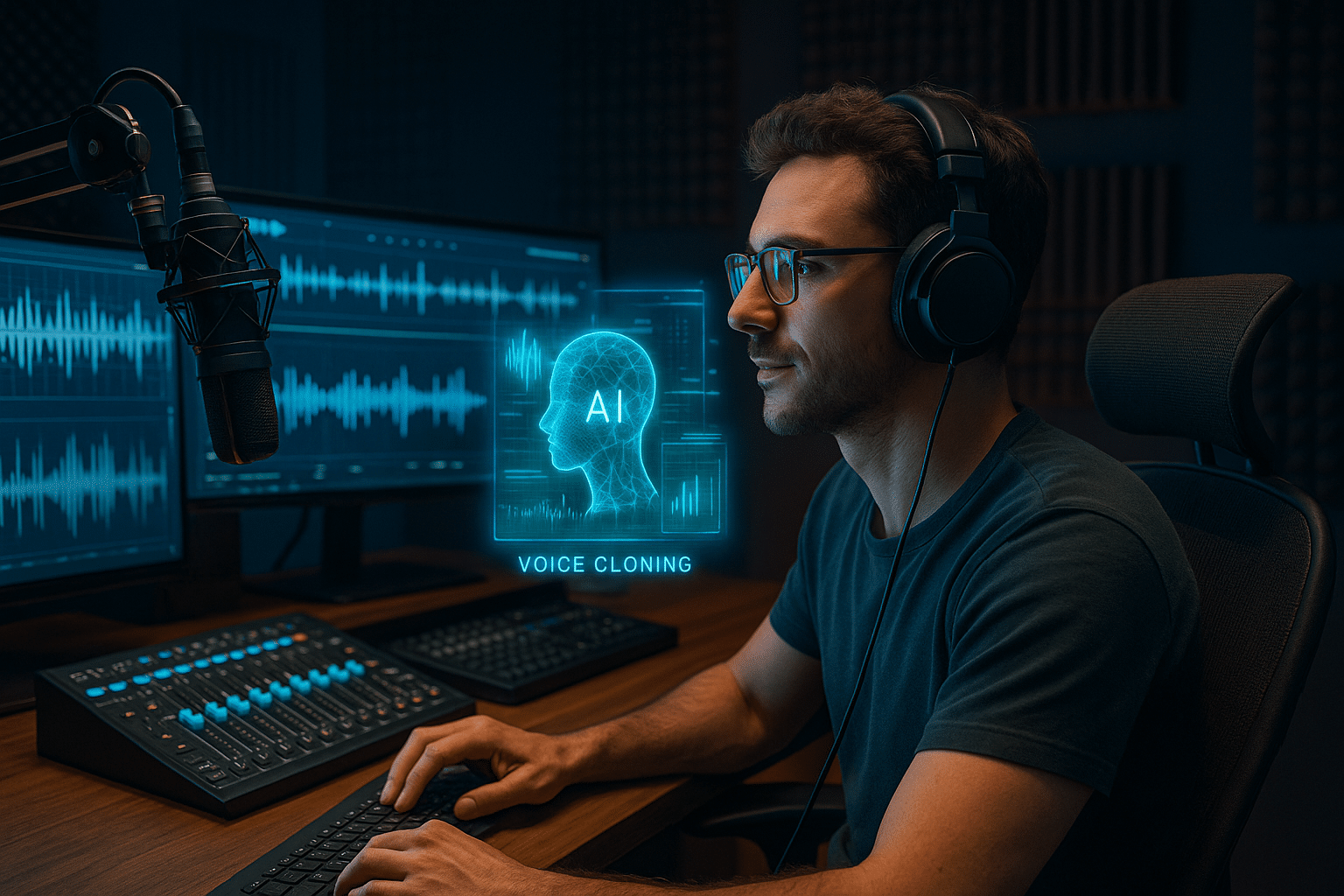This technology allows creators to emulate a specific voice, unlocking a plethora of opportunities in content generation. But how can creators effectively harness the power of AI voice cloning to create engaging, authentic content? Let’s delve into this fascinating topic and unveil its enormous potential. 🚀
As with every technological breakthrough, understanding the basics is crucial before diving headfirst into its implementation. AI voice cloning, also referred to as voice synthesizing, involves the usage of deep learning techniques to generate a unique digital voice identical to a specific human voice. These AI models are trained on vast datasets, learning the intricate nuances of human speech and thereby creating a realistic, high-quality voice clone.
The application of AI voice cloning in content creation is extensive and continually growing. From enhancing podcast audios, creating engaging video narrations, personalizing customer service interactions to developing innovative gaming experiences – the possibilities are limitless. Hence, mastering this tool can undoubtedly provide creators with a competitive edge in the highly saturated content market. 🎯
However, the journey to effectively using AI voice cloning for content creation is not without challenges. A clear understanding of the underlying technology, careful selection of the right tools, ethical considerations, and a knack for maintaining authenticity in the cloned voice are vital. So, buckle up as we navigate through these aspects to help you make the most out of AI voice cloning for content creation.
Understanding AI Voice Cloning Technology
To begin with, let’s break down the underlying technology behind AI voice cloning. In simple terms, it’s a three-step process. First, the AI model is trained on hours of speech data, learning the specific voice’s acoustic and linguistic features. Then, the model generates a unique voiceprint, a digital representation of the original voice. Finally, using this voiceprint, the model can synthesize new speech content in the learned voice. This deep dive into the technology will help you appreciate the intricacies involved and guide you in creating high-quality voice clones.
Choosing the Right AI Voice Cloning Tools
Next, we will explore the myriad of AI voice cloning tools available in the market. Each tool comes with its unique features, capabilities, and limitations. We’ll guide you through the factors you need to consider while choosing a tool that best suits your content creation needs. These include the tool’s accuracy, the range of voices available, its user interface, pricing, and more. Finding the right tool is a game-changer, enabling you to create top-notch voice cloned content with ease. 🛠️
Maintaining Authenticity in AI Voice Cloning
One of the key challenges in AI voice cloning is maintaining authenticity. An artificially cloned voice devoid of emotion and context can come across as robotic and disengaging. To avoid this pitfall, we’ll discuss strategies to infuse your voice clones with life, keeping them contextually appropriate and emotionally resonant. Remember, the goal is not just to mimic a voice but to create content that speaks to your audience. 🎙️
Ethical Considerations in AI Voice Cloning
Finally, we will touch upon the ethical considerations involved in AI voice cloning. The technology’s potential misuse raises critical questions about consent, privacy, and potential for deception. As creators, it’s essential to understand these aspects and navigate the ethical landscape responsibly. Your credibility and audience trust depend on it. ⚖️
As we embark on this exploratory journey, you’ll gain valuable insights, essential tips, and practical guidance on unlocking the power of AI voice cloning. So, prepare to leap into this exciting frontier of content creation. The future of voice is here, and it’s artificially intelligent!
Unleashing the Power of AI Voice Cloning: A Deep Dive into Techniques and Strategies
The fascinating world of artificial intelligence (AI) has given rise to several groundbreaking technologies, among which voice cloning stands out. Through advanced algorithms and intricate programming, AI can now replicate human voices with an astonishing degree of precision, opening up a plethora of opportunities for content creators. This article aims to offer a comprehensive guide on how to leverage AI voice cloning to create authentic and engaging content.
📌 If you’re a content creator looking to utilize AI voice cloning, this is your go-to resource. We’ll delve into what voice cloning is, its applications, and essential tips to keep in mind.
🔎 Make sure to check out the YouTube video “Deep Voice: Real-time Neural TTS by Siraj Raval” for an interactive explanation of how AI voice cloning works.
Understanding AI Voice Cloning: The Basics and Beyond
Before diving into the practical applications and tips for creators, it’s vital to grasp the fundamental principles of AI voice cloning. Voice cloning refers to the technique of creating a synthetic voice that closely resembles a specific human voice. This process involves capturing the unique vocal characteristics of a person, such as pitch, tone, and accent, then training an AI model to mimic these traits.
The advancements in machine learning and deep learning techniques have revolutionized the process of voice cloning. Deep learning, in particular, has proved to be pivotal, with models such as DeepVoice by Baidu and Tacotron by Google leading the charge.
These models learn to synthesize speech by training on massive datasets of human speech. After training, they can generate speech that’s almost indistinguishable from the real voice they were trained on.
How AI Voice Cloning Works: A Technical Perspective
The core technology behind AI voice cloning is a type of deep learning known as sequence-to-sequence (Seq2Seq) learning. This model takes an input sequence (text) and generates an output sequence (speech). It’s composed of two primary components – an encoder and a decoder.
The encoder converts the input text into an abstract representation that captures the underlying meaning, while the decoder transforms this abstract representation into speech. The model is trained on large datasets of speech to fine-tune this conversion process.
🎥 For a deeper understanding of Seq2Seq learning, consider watching the YouTube video “Sequence to Sequence Deep Learning (Quoc Le, Google)” on the Google Developers channel.
Key Applications of AI Voice Cloning for Content Creators
AI voice cloning offers a wealth of opportunities for content creators, enabling them to experiment with different voices and styles without the need for professional voice actors. From podcasting to video production, the possibilities are limitless.
One popular application is in the creation of audiobooks. AI voice cloning allows content creators to produce audiobooks with multiple character voices, adding depth and variety to the storytelling experience.
AI voice cloning can also be used in video content creation. For instance, creators can use cloned voices to dub their videos in different languages, thereby reaching a wider audience. Alternatively, they can use AI voices to narrate their videos, especially when the content calls for a specific voice style or accent.
Audiobook Creation with AI Voice Cloning
Imagine creating an audiobook where each character has its unique voice, bringing the story to life. With AI voice cloning, this is no longer a dream but a reality. You can clone the voices of different characters and use these voices to narrate your audiobook.
Not only does this add depth to your content, but it also enhances the listener’s experience, making your content more engaging and appealing. But remember, the key to success lies in choosing the right voices for your characters and ensuring the voice cloning is done professionally.
🎧 To see this in action, check out the YouTube video “Audiobook Creation with AI Voice Cloning” on the OpenAI channel.
Essential Tips for Creators Using AI Voice Cloning
As exciting as AI voice cloning is, it’s important for creators to use this technology responsibly and effectively. Here are a few tips that can help you make the most of AI voice cloning.
1. Prioritize Quality Over Quantity: While AI voice cloning allows you to experiment with a wide range of voices, it’s essential to focus on the quality of the voice clones. A poorly cloned voice can detract from your content, so ensure you use high-quality AI models and training data.
2. Choose the Right Voice for Your Content: The voice you use can significantly impact how your content is perceived. Think about the tone, accent, and style that best suit your content, and use voice cloning to achieve this.
3. Respect Privacy and Legal Considerations: Remember that voice cloning involves replicating a person’s unique vocal characteristics. Therefore, ensure you have the necessary permissions to use someone’s voice, and be aware of the legal and ethical considerations involved.
Finally, keep in mind that AI voice cloning is a tool to enhance your content, not replace human creativity. While it can add depth and variety to your content, the story and message you convey are ultimately what will connect with your audience.
🔔 Interested in learning more about AI and content creation? Watch the YouTube video “The Future of AI in Digital Marketing” on the Neil Patel channel for further insights.

Conclusion
In conclusion, it’s evident that the landscape of IT and engineering is perpetually evolving, challenging us to continuously advance our understanding and adapt to the ongoing technological changes. Reflecting on the key points discussed throughout this article, the criticality of agile methodology, the importance of cybersecurity, and the potential of artificial intelligence have been emphasized.
Firstly, we dissected the principles of Agile methodology, and it was clearly articulated how it has become a game-changer in project management, especially within the software development realm. Agile promotes a flexible and customer-centric approach, allowing teams to deliver high-quality software at a faster pace. If you’re interested in knowing more about this topic, you might want to check this detailed guide on Agile methodology from ActiveLink.
Furthermore, we dived deep into the subject of cybersecurity, an area that is rapidly gaining significance as our reliance on digital platforms increases. We highlighted the need for stringent security measures and enlightened readers about the ways to safeguard themselves from potential cyber threats. For a more comprehensive understanding of this topic, you can visit this article by Cyber Defense.
Finally, the exciting world of artificial intelligence was explored. We discussed how AI has the potential to revolutionize various sectors, ranging from healthcare to transportation. For a deep dive into this fascinating technology, refer to this extensive guide by AI Intelligence.
Without a doubt, these topics not only hold relevance in the present day but will continue to shape our future. Whether you are an IT professional, an engineer, or an enthusiast, understanding these concepts will enable you to stay ahead of the curve. 🚀
I hope this article has been insightful, further fueling your passion for technology and engineering. If there are any aspects you’d like to discuss further or any topics you’d like us to cover next, feel free to comment below. Sharing this article could also help your colleagues and friends stay updated with the latest trends in IT and engineering. 🌐
In the world of technology, learning never ceases. Let’s keep exploring, innovating, and evolving. Remember, the future belongs to those who are prepared to create it. 💡
References:
ActiveLink – Agile Guide
Cyber Defense – Cybersecurity Guide
AI Intelligence – AI Guide
Until next time, keep learning, stay curious, and embrace the technological revolution. 🌟
Tags: Agile Methodology, Cybersecurity, Artificial Intelligence



